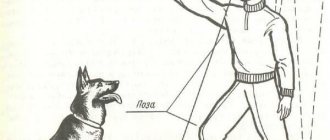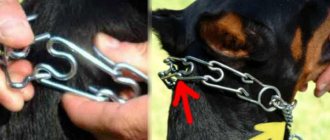The course has been updated in June 2022! Many improvements have been introduced.
Learn basic training skills for your dog online! The best option for taking the first steps in education. The videos were filmed by Irina Chushikina, a dog handler with 10 years of experience.
| Number of videos | Price |
| One lesson | 1,000 rub. |
| Entire course (5 lessons) | 6,000 rub. 5,000 rub. |
Sit
Take a treat in your hand and bring your fist to your pet's face so that he can smell the smell. Slowly raise your hand up so that the dog reaches for the treat, lifting its nose. At this moment, intuitively, dogs most often sit down.
Voice the command. If the dog sits on his own, give him a treat. If not, repeat the command and lightly press your hand on the sacrum. After several such repetitions, the animals understand what is wanted from them.
Second phase. Once the dog begins to sit, it becomes simply unbearable to receive the coveted treat.
The dog may sit for a second or two, and then explode and begin wagging its tail, jumping and demanding a treat. At this moment you can’t give him anything. You need to sit the dog down again, wait about five seconds, and only then praise him for the exercise.
When the dog stops jumping up before receiving the treat, move on to the third stage. Along with voicing the command, show it with a gesture (see figure). A command is considered to be learned when the dog begins to execute it at a distance of 2–3 m.
Graphics: Dmitry POLUKHIN
Who is it suitable for?
- for those who recently adopted a puppy and want to teach basic skills.
- for those who decide to start training an adult dog.
- those who wanted to teach the dog to feel his body, concentrate on the task at hand and carry it out clearly.
Lie
If your pet has learned the “sit” command, consider that he has almost learned the “lie down” command. We give the command “sit”, wait for the four-legged dog to fulfill it, after which we show him a treat in his hand, which we gradually move to the side at floor level. At this moment, when the animal begins to reach for the treat, we give the command “lie down” and press a little on the dog’s withers, preventing it from jumping up on its paws. The dog will reach for the hand with the treat and stretch into the correct position.
The second stage is to learn this command using a gesture (see figure). Add the gesture to the voice command when the pet begins to lie down on its own, without your hand on the withers. Then gradually increase the distance from which the dog executes the command.
Graphics: Dmitry POLUKHIN
How to train a dog without raising your voice at him
It is very important for the owner to know how to raise a dog without shouting during its training. You should speak to your pet sternly and assertively, showing your leadership. At the same time, you should never yell at your dog. Your screams will only make your dog afraid of you and not do what you ask of him.
Stand
It is better to learn this command when the dog learns to lie down when ordered. The lying position will be the starting position. The pet must be wearing a collar and on a leash. Lift your dog up by the leash until he stands on his paws. Voice the command and give a treat when the animal takes a stance. Treat him with a treat when the dog is standing upright, not trying to sit down on his butt.
Graphics: Dmitry POLUKHIN
Training
The process by which dogs are taught certain commands and given some kind of stimulus is called training. After the training process is completed, the dog always obeys the owner and follows all his orders. Simply put, the dog learns good behavior through training. All these acquired skills relate exclusively to one person - the dog's owner. This means that it will only carry out commands expressed from the mouth of the owner. The dog gives him the right to lead and command in their pair; this does not concern the rest of the family members, and especially strangers.
To me
You'll need an assistant here. You need someone to hold your puppy or on a leash while you walk a short distance away from him.
Stop, pat your hand on your thigh and say, “Come to me.” At this moment, the dog should be released so that it runs towards you. If he doesn’t run, squat down, start calling and show him the treat in your hands. When the puppy approaches, give him a treat and pet him.
If the dog ignores your command several times, pause and do something else, put it on a leash or leave the stick. Otherwise, the animal will decide that it is okay to disobey you.
Punishment during training
It is not recommended to use punishment during training.
REFERENCE! Punishment can be used very rarely and only for educational purposes, not during training.
To raise a puppy well, you need to determine for yourself what the puppy can and cannot do. Then, if the puppy commits prohibited actions, he should be punished immediately. If you punish an hour after the offense, the puppy will not understand the connection between these events and may show aggression towards you.
To punish, you need to take the puppy by the scruff of the neck and shake him. Afterwards, you need to express all your complaints in a stern voice and leave the room where the dog is.
If the puppy accepts punishment, he must lower his head, which means the pet has understood everything and most likely this will not happen again. If, after punishment, the dog bites you or snaps at you, then it is necessary to carry out the punishment a second time so that the puppy learns the lesson of who is the leader here.
Place
Training consists of several stages. Training should begin when your little friend knows the commands “lie down” and “come to me.”
Choose a place, lay a rug, a blanket there, or place a special lounger, then place a toy or bone nearby and start training.
Step one. Bring the dog to his place and say: “Lie down.” After this, move a short distance and call your pet to you. When the dog follows the command, give reinforcement and praise.
Step two. Repeat the exercise, but now point towards the sunbed with your hand and say: “Place.” The puppy can be slightly pushed in this direction by repeating the command. If the dog settles down, say “Place” again. If he doesn’t want to, give the command “lie down”, wait for it to be completed and repeat the command “place”. Thank you with a tasty treat, then walk back a few steps and call your pet to you.
Step three. Leave a treat on the bedding or, better yet, hide it in a toy to make it more interesting for your dog to look for it. Voice the command “place”. When the dog comes up to eat the treat, say: “Lie down,” praise him for following the command, and while he lies on the mat for at least 5 seconds, repeat the “place” command and treat him with the treat again.
After a few days of training, increase the distance from which the dog approaches its place to several meters.
– Basic commands, such as “sit”, “lie down”, “stand”, can be taught by yourself, but complex ones, for example, “barrier”, “die”, “fetch”, “jump on the back” - only with a dog handler. In these teams, you need to carefully monitor the execution technique, and in some exercises you even need to catch the dog, warns dog handler Zlata Obidova. – The general training course lasts two months, after which, if the dog has learned everything, a certificate is issued. But everything is individual. For some animals, even 15–20 sessions may not be enough.
When signing up for courses, pay attention to what breeds of dogs are recruited into the group. Animals must be similar in size. Dwarf breeds cannot be trained together with fighting breeds.
When to start training a puppy
The first step, after purchasing a puppy, is to study information about its breed and its characteristics. This data can greatly help the owner in raising him. Given information about the characteristics of the puppy’s breed, you can be aware of his preferences or dislikes. It is of great importance whether it is a German Shepherd, Husky, Labrador, Husky, or Mongrel puppy, which are larger in size and have a certain stable character, or whether it is a Yorkie or Jack Russell Terrier puppy, which are small in size and have a more unbalanced psyche.
ATTENTION! If you want to have a good relationship with your dog, you need to spend enough time with your puppy to build trust between you.
Considering all of the above, the answer to the question of what time a puppy begins to be trained is very simple. You need to start from the very minute you just brought it into your apartment or house. If the dog has been in your home since birth, then training should begin at one month of age.
Popular questions and answers
We talked with dog trainer Zlata Obidova about what other points should be taken into account when training a puppy .
At what age can a puppy be taught commands?
You can teach your puppy commands from the age of 4 months, when all vaccinations have been completed and quarantine has passed. It is best to train your dog in the morning and evening before the main meal, then the pet will be more willing to follow commands.
How often should a puppy be taught commands?
It is advisable to carry out training every day so that the pet does not lose the habit. But it shouldn't take much time. Don't repeat each command a hundred times. 3 – 5 repetitions are enough, after which take a break.
How to reward a dog for following a command?
Treats that she loves.
But it is important to remember that the interval after executing the command and receiving the treat should not be more than 3 seconds. When the dog begins to follow commands well, you need to wean it off treats. Give a treat not for each completed exercise, as was the case in the beginning, but after 2 - 3 correctly executed commands. Instead of treats, you can pet and praise. Sources
- Khainovsky A.V., Goldyrev A.A. On modern methods of training service dogs // Perm Agrarian Bulletin, 2020 https://cyberleninka.ru/article/n/o-sovremennyh-metodikah-dressirovki-sluzhebnyh-sobak
- Panksepp J. Affective neuroscience: The foundations of human and animal emotions // New York, Oxford University Press, 2004 – 408 p.
How to raise a dog correctly with patience
When you want to understand how to raise a dog , making it disciplined and obedient, remember how small children are raised. When you tell a small child “No” or “Don’t do that!”, you hardly expect the child to listen to you the first time. The same story happens with the dog.
Don't expect her to understand what you want from her the first time. Training your dog to behave well takes practice.
Secrets of perfect parenting
In the video, professional trainer Don Sullivan gives tips on raising your pet, changing behavior and building relationships with it. Good education depends on the right methodology. Important: the dog must recognize the owner as the leader. Well-trained dogs enjoy more freedom, exercise, and love throughout their lives. It is better to train at three months of age. Later, stubbornness may develop. Sullivan's method is a combination of encouragement and obedience, proving the owner's superiority over the dog and correcting behavior. Using the advice of a professional, you can easily teach your pet essential skills.
How to raise a dog with the help of friends
Your friends may not know how to raise a dog correctly. However, they are quite capable of helping you in this difficult matter. With the help of your friends, you can teach your dog to enjoy the company of other people, not be afraid of them, and at the same time not be aggressive towards them.
Invite your friends to play with your dog or let them boss him around for a while. Let your friends command your dog to “Sit!” or “Lie down!” All this will teach your dog to respond normally to other people and enjoy their company.
Teaching the "voice" command
The most fun, favorite among German shepherds, and although it is not mandatory and is not required when passing a general training course, almost all dogs know it. Puppies learn the easiest way, after which they are happy to demonstrate their skills to everyone.
For testing:
- The puppy is called over and shown a piece of treat held in the palm of his hand.
- The baby shows interest, after which the treat is raised above his head, repeating “voice!” in an excited tone. Most often, the puppy begins to jump, trying to get to the tasty morsel, then, disappointed, sits down and begins to yelp.
- That’s when you need to praise the baby, rejoice wildly and give him the cookies.
- Immediately fix it by repeating everything from the beginning.
If your puppy is not interested in food enough to get it, you can try the same trick with a toy. A ball that cannot be taken from its owner is no worse than a cookie. After trying to bark, even if it is a thin squeak, the puppy is praised and given a toy, after which you need to play with it a little.











